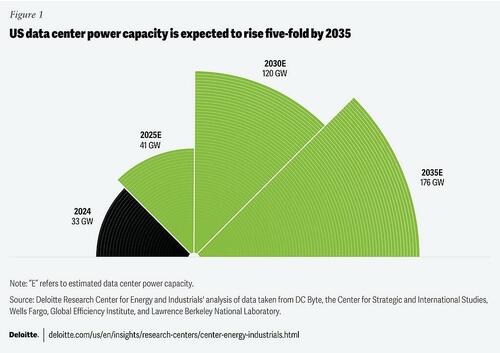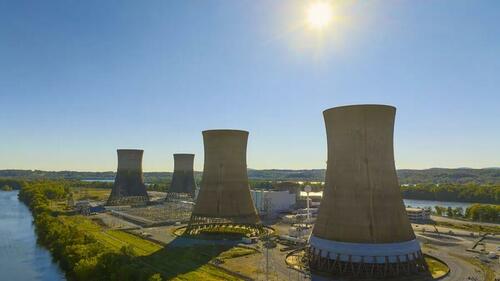By Brian Martucci of UtilityDive
Summary:
- New nuclear power capacity could meet about 10% of the projected increase in data center electricity demand by 2035, Deloitte said in an April 9 report.
- Deloitte expects data centers to consume about 30%, or 11 GW to 19 GW, of the estimated 35 GW to 65 GW of new nuclear capacity added over the next decade through a combination of power uprates at operational plants, restarts of recently-retired reactors, and new reactor deployments at greenfield and existing power plant sites.
- Existing nuclear power plants and retired or retiring coal power plant sites will support the vast majority of new nuclear capacity interconnection, with respective contributions ranging from 10 GW to 20 GW and 20 GW to 30 GW, Deloitte said.
Deloitte expects total U.S. data center electricity demand to increase five-fold from 33 GW in 2024 to as much as 176 GW in 2035, based on its analysis of recent projections from DC Byte, Wells Fargo and others, it said in the report.
Along with transportation electrification, data center growth will drive an expected 50% increase in U.S. electricity demand through 2050, the National Electrical Manufacturers Association said earlier this month in a separate report.
Deloitte’s forecast is sensitive to changes in the rate and scale of data center deployment, but nuclear has inherent advantages — reliability, high capacity factor, low emissions, compact physical footprint and competitive energy costs over assets’ multi-decade operational lives — that make it attractive across a range of scenarios, the consultancy said.
“We think you’re going to see people looking at existing nuclear infrastructure and adding capacity through those assets, then placing bets on technology development,” said Martin Stansbury, report co-author and principal in Deloitte’s Energy, Resources & Industrials practice.
The tech-giant “hyperscalers” driving the data center boom have already done both. In September, Microsoft and Constellation Energy announced a 20-year power purchase agreement that would enable the undamaged, 835-MW reactor at Constellation’s Three Mile Island plant to resume operations by 2028. The reopening of the Pennsylvania plant, since renamed the Crane Clean Energy Center, is ahead of schedule, Constellation said earlier this year.
Also last fall, Amazon, Google and Meta each announced significant efforts to meet future energy demand with new nuclear capacity. Amazon could deploy more than 5 GW of new capacity by 2039 using X-energy’s small modular reactor technology, Google tapped Kairos Power to provide 500 MW of SMR capacity by 2035, and Meta issued a request for proposals for up to 4 GW of new nuclear deployments beginning in the early 2030s.
Despite those long lead times and recent Trump administration efforts to prop up the U.S. coal industry, new nuclear is likely to find a niche as a reliable source of increasingly cost-competitive baseload power, Stansbury said.
“SMRs have a major role to play in future grid reliability,” he said.
SMRs have additional benefits for data centers in particular, including more secure fuel forms, self-starting and grid “islanding” capabilities, and the ability to operate continuously for long periods of time, Deloitte said.
Existing nuclear and coal-fired power plants could support much of the new generation capacity the U.S. data center industry needs in the coming decade. The U.S. Department of Energy projected last year that U.S. nuclear and coal power sites could host up to 269 GWe of new nuclear, and at least 11 states have expressed interest in supporting coal-to-nuclear conversions, Deloitte said.
But with 2024 construction costs ranging from $6,417/kW to $12,681/kW, compared with $1,290/kW for new gas-fired power plants, nuclear developers have a lot of work to do to bring down costs in the coming years, Deloitte said. To scale, the industry needs to invest in advanced project management processes, design innovations like digital twinning, and further improvements in modular construction, it said.
Loading...

